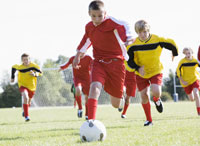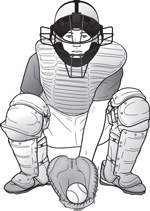
A Guide to Safety for Young Athletes
For young athletes, sports activities are more than play. Participation in athletics improves physical fitness, coordination, and self-discipline, and gives children valuable opportunities to learn teamwork.
 © 2013 Thinkstock
© 2013 Thinkstock
Because young athletes are still growing, they are at a greater risk for injury than adults. The consequences of overdoing a sport can include injuries that impair growth, and may lead to long-term health problems.
Fortunately, many youth sports injuries can be prevented. Some of the more effective ways to prevent these injuries include age-specific coaching, appropriate physical conditioning, and proper use of equipment.
In addition, coaches and parents can prevent injuries by fostering an atmosphere of healthy competition that emphasizes confidence, cooperation, and a positive self-image, rather than just winning.
Differences Between Child and Adult AthletesChildren Are Still Growing
The young athlete is not a smaller version of an adult. Children's bones, muscles, tendons, and ligaments are still growing, making them more susceptible to injury. In addition, there are significant differences in coordination, strength, and stamina between children and adults.
Children Vary in Size and Maturity
Young athletes of the same age can differ greatly in size and physical maturity. Grade school students are less likely to experience severe injuries during athletic activities because they are smaller and slower than older athletes. High school athletes, however, are bigger, faster, stronger, and capable of delivering tremendous forces in contact sports.
Children Can Injure Growth Plates
Growth plates are the areas of developing cartilage at the ends of long bones where bone growth occurs in children. The growth plates are weaker than the nearby ligaments and tendons. A twisted ankle that might result in a sprain in an adult, could result in a more serious growth plate fracture in a young athlete. Growth plate injuries have the potential to disrupt the normal growth of bone.
Common Youth Sports InjuriesAcute Injuries
Acute sports injuries are caused by a sudden trauma, such as a twist, fall, or collision. Common acute injuries include broken bones, sprains (ligament injuries), strains (muscle and tendon injuries), and cuts or bruises.
Most acute injuries should be evaluated by a doctor. Prompt first aid treatment should be provided by coaches and parents when the injury occurs. This usually consists of the RICE method: rest, applying ice, wrapping with elastic bandages (compression), and elevating the injured arm, hand, leg, or foot. This usually limits discomfort and reduces healing time. Proper first aid will minimize swelling and help the doctor establish an accurate diagnosis.
Overuse Injuries
Overuse injuries occur gradually over time, when an athletic activity is repeated so often, parts of the body do not have enough time to heal between playing. Examples of overuse injuries include throwing injuries in the elbow, Achilles tendinitis, and shin splints.
Coaches may have more difficulty spotting less severe problems, however, because the pain is low grade and the athlete often ignores it. Repeat injuries may turn into overuse conditions, which can put the athlete on the sidelines for the rest of the season.
To keep athletes in the game long-term, overuse injuries need to be diagnosed and treated by a physician as soon as possible. Parents and coaches should be aware of the more common signs of overuse injury. These include:
- Pain. This pain cannot be tied to an acute injury, such as from a fall. The pain often increases with activity
- Swelling
- Changes in form or technique
- Decreased interest in practice
In the growing athlete's musculoskeletal system, pain from repetitive motion may appear somewhere besides the actual site of the injury. For instance, a knee ache in a child or adolescent may actually be pain caused by an injury to the hip.
Whether an injury is acute or due to overuse, a child who develops a symptom that persists or that affects his or her athletic performance should be examined by a doctor. A child should never be allowed to "work through the pain."
Strategies for Preventing Youth Sports InjuriesThere are several strategies that coaches, parents, and athletes can follow to help prevent sports injuries. Most importantly, athletes should:
 Proper protective gear for a baseball catcher.
Proper protective gear for a baseball catcher.
- Be in proper physical condition to play a sport (a pre-participation sports physical examinations can be very useful in screening for potential problems)
- Know and abide by the rules of a sport
- Wear appropriate protective gear (for example, shin guards for soccer, a hard-shell helmet when facing a baseball pitcher, a helmet and body padding for ice hockey)
- Know how to correctly use athletic equipment (for example, correctly adjusting the bindings on snow skis)
- Always warm up before playing
- Stay hydrated
- Avoid playing when very tired or in pain
Proper Training
Young athletes need proper training for sports. They should be encouraged to train for the sport rather than expecting the sport itself to get them in shape.
Young athletes also should follow a regular conditioning program (in conjunction with their coach) with incorporated exercises designed specifically for their chosen sport. In addition, a well-structured, closely supervised weight-training regimen may modestly help youngsters prepare for athletic activities.
STOP Sports Injuries
Many sports injuries in young athletes — particularly elbow and knee injuries — are caused by excessive, repetitive stress on immature muscle-bone units. Doctors are seeing an increase in overuse injuries because many young athletes are focusing on just one sport and are training year-round. The American Academy of Orthopaedic Surgeons has partnered with STOP Sports Injuries to help educate parents, coaches, and athletes about how to prevent overuse injuries. Specific tips to prevent overuse injuries include:
- Limit the number of teams in which your child is playing in one season. Kids who play on more than one team are especially at risk for overuse injuries.
- Do not allow your child to play one sport year round - taking regular breaks and playing other sports is essential to skill development and injury prevention.
Atmosphere of Healthy Competition
Coaches and parents are also responsible for creating an atmosphere that promotes teamwork and sportsmanship.
Youth sports should always be fun. The "win at all costs" attitude of many parents, coaches, professional athletes and peers can lead to injuries. A young athlete striving to meet the unrealistic expectations of others may ignore warning signs of injury and continue to play with pain.
Young athletes must learn to deal with success and defeat in order to place events in a proper perspective. The promotion of the "win at all costs" ethic can have both short-term and long-term detrimental effects on impressionable young athletes.
Special ConsiderationsFemale Athletes
Sports and exercise are healthy activities for girls and women of all ages. The participation of girls and young women in sports has increased significantly since the passage of Title IX. Occasionally, a female athlete who focuses on being thin or lightweight may eat too little or exercise too much. Doing this can cause long-term health damage.
Three interrelated illnesses may develop when a girl or young woman goes to extremes in dieting or exercise. Together, these conditions are known as the "female athlete triad."
The three conditions are:
- Disordered eating
- Menstrual dysfunction
- Premature osteoporosis (low bone density for age)
Treatment for female athlete triad often requires help from a team of medical professionals including your doctor, your athletic trainer, a nutritionist, and a psychological counselor.
Steroid Use
Many young athletes — boys and girls — use black-market anabolic steroids to improve their athletic performance. Steroids have been shown to increase muscle mass, but they can cause serious and potentially life-threatening complications and should be avoided. Most steroids are illegal and are banned by sports organizations.
Sports Supplements
Many athletes of all ages take sports supplements, such as creatine, because they think it will increase strength and improve sports performance.
The U.S. Food and Drug Administration does not regulate nutritional supplements. This means that the supplement products available in stores may vary in amount and quality, and there is no guarantee of safety or purity.
There is also not enough research on the long-term health effects of taking sports supplements, especially in adolescents and children who are still growing.
No matter what your age or health condition, always see your doctor for advice before taking nutritional supplements.
Benefits of Sports ParticipationAthletic activity by young people is generally safe with low risks and high benefits. The major goal should be enjoyable participation. Exposure to competitive and noncompetitive sports encourages the development of fitness, motor skills, social skills, and a life-long appreciation for sports.
Source: http://orthoinfo.aaos.org/topic.cfm?topic=A00307
